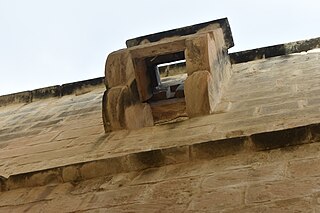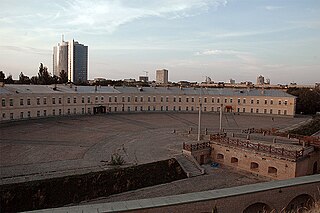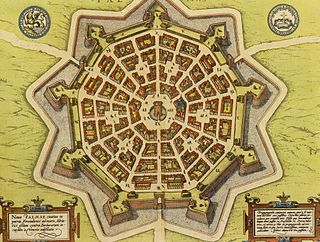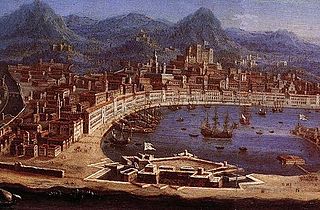
Medieval fortification refers to medieval military methods that cover the development of fortification construction and use in Europe, roughly from the fall of the Western Roman Empire to the Renaissance. During this millennium, fortifications changed warfare, and in turn were modified to suit new tactics, weapons and siege techniques.

In architecture, a turret is a small tower that projects vertically from the wall of a building such as a medieval castle. Turrets were used to provide a projecting defensive position allowing covering fire to the adjacent wall in the days of military fortification. As their military use faded, turrets were used for decorative purposes, as in the Scottish baronial style.

A machicolation is a floor opening between the supporting corbels of a battlement, through which stones or other material, such as boiling water or boiling cooking oil, could be dropped on attackers at the base of a defensive wall. A smaller version found on smaller structures is called a box-machicolation.

The Kiev Fortress is a complex of Russian fortifications in Kiev, Ukraine built over the span of the 17th through 19th centuries, soon after the 1654 Council in Pereyaslav, based on already existing fortified monastery of Kiev Pechersk Lavra.

Fort Manoel is a star fort on Manoel Island in Gżira, Malta. It was built in the 18th century by the Order of Saint John, during the reign of Grand Master António Manoel de Vilhena, after whom it is named. The British military took over the fort in 1800, when it became known as HMS Phoenicia, and it remained in use by them until 1964. The fort was severely damaged in World War II, but it was restored and it is now in good condition.

A bastion fort or trace italienne, is a fortification in a style that evolved during the early modern period of gunpowder when the cannon came to dominate the battlefield. It was first seen in the mid-15th century in Italy. Some types, especially when combined with ravelins and other outworks, resembled the related star fort of the same era.

An outwork is a minor fortification built or established outside the principal fortification limits, detached or semidetached. Outworks such as ravelins, lunettes (demilunes), flèches and caponiers to shield bastions and fortification curtains from direct battery were developed in the 16th century. Later, the increasing scale of warfare and the greater resources available to the besieger accelerated this development, and systems of outworks grew increasingly elaborate and sprawling as a means of slowing the attacker's progress and making it more costly. When taken by an enemy force, their lack of rear-facing ramparts left them totally open to fire from the main works.

Enceinte is a French term denoting the "main defensive enclosure of a fortification". For a castle this is the main defensive line of wall towers and curtain walls enclosing the position. For a settlement it would be the main town wall with its associated gatehouses and towers and walls.

An alcazaba, alcáçova or alcassaba is a Moorish fortification in Spain and Portugal. The word derives from the Arabic word القصبة (al-qasbah), a walled-fortification in a city.

A scarp and a counterscarp are the inner and outer sides of a ditch or moat used in fortifications. Attackers must descend the counterscarp and ascend the scarp. In permanent fortifications the scarp and counterscarp may be encased in stone. In less permanent fortifications, the counterscarp may be lined with paling fence set at an angle so as to give no cover to the attackers but to make advancing and retreating more difficult.

The Floriana Lines are a line of fortifications in Floriana, Malta, which surround the fortifications of Valletta and form the capital city's outer defences. Construction of the lines began in 1636 and they were named after the military engineer who designed them, Pietro Paolo Floriani. The Floriana Lines were modified throughout the course of the 17th and 18th centuries, and they saw use during the French blockade of 1798–1800. Today, the fortifications are still largely intact but rather dilapidated and in need of restoration.

A ditch in military engineering is an obstacle, designed to slow down or break up an attacking force, while a trench is intended to provide cover to the defenders. In military fortifications the side of a ditch farthest from the enemy and closest to the next line of defence is known as the scarp while the side of a ditch closest to the enemy is known as the counterscarp.

A bailey or ward in a fortification is a courtyard enclosed by a curtain wall. In particular, an early type of European castle was known as a motte-and-bailey. Castles can have more than one bailey. Their layout depends both on the local topography and the level of fortification technology employed, ranging from simple enclosures to elaborate concentric defences. In addition to the gradual evolution of more complex castle plans, there are also significant differences in regional traditions of military architecture regarding the subdivision into baileys.

The fortifications of Malta consist of a number of walled cities, citadels, forts, towers, batteries, redoubts, entrenchments and pillboxes. The fortifications were built over thousands of years, from around 1450 BC to the mid-20th century, and they are a result of the Maltese islands' strategic position and natural harbours, which have made them very desirable for various powers.

The fortifications of Mdina are a series of defensive walls which surround the former capital city of Mdina, Malta. The city was founded as Maleth by the Phoenicians in around the 8th century BC, and it later became part of the Roman Empire under the name Melite. The ancient city was surrounded by walls, but very few remains of these have survived.

The Real Cittadella was a fort in Messina, Sicily. The Cittadella was built between 1680 and 1686 by the Spanish Empire, and it was considered to be one of the most important fortifications in the Mediterranean. Most of the fort was demolished in the 20th century, but some parts can still be seen.

In fortification, the term entrenchment can refer to either a secondary line of defence within a larger fortification, or an enceinte designed to provide cover for infantry, having a layout similar to a city wall but on a smaller scale. The latter usually consisted of curtain walls and bastions or redans, and was sometimes also protected by a ditch.

An Abwurfdach was an easily dismantled construction that protected the curtain walls, cavaliers and bastions of several early modern fortresses. It was once believed that this construction was as old as the 12th century, but most modern historians maintain that the first abwurfdachs were constructed around 1550.






















